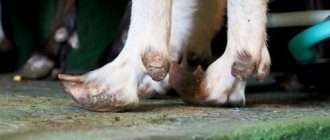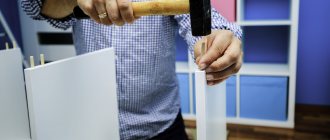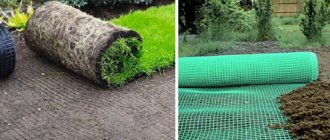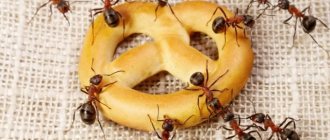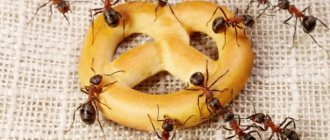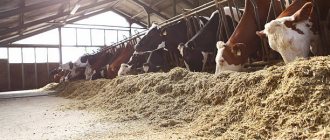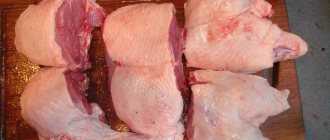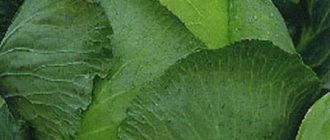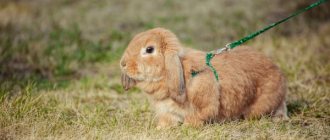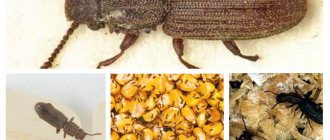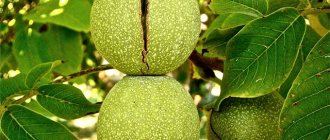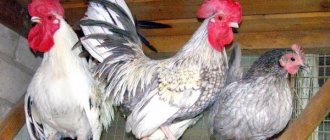In order not to spend money on a ready-made machine for restraining animals, you need to study our instructions, which will tell you how to make a split for cattle with your own hands. This is the name given to a special frame or box for limiting the mobility of a cow. It is indispensable when examining, treating or processing livestock. Ready-made machines are expensive, they need to be ordered, and any modification to suit the customer’s needs only increases the cost. It’s easier, cheaper and more convenient to make such a device yourself.
The process of trimming hooves on a machine
The outer stratum corneum on the hoof is designed to protect the inside of the hoof.
It constantly grows, forming solid nodules and growths. If it is not trimmed periodically, the animal will experience discomfort when walking and begin to limp. Important! When cracks appear in the stratum corneum, there is a high probability of infections, which will lead to serious health problems and reduce the productivity of the cow.
Hoof trimming rules
For the first time, such a procedure should be carried out under the guidance of an experienced specialist; it is also important to know the frequency of the procedure. Basic rules for pruning:
- When cows are kept in stalls, the procedure is carried out up to three times a year, and when cows are kept free-stall - twice a year.
- The day before the planned trimming, the cow is kept on a damp bedding to soften the horny formations, which will facilitate the process.
- It is necessary to prepare a number of tools and be sure to disinfect them before work.
- You need to make sure that the animal is comfortable and that the straps hold it securely.
- If the animal is too excited, you can sedate it.
- Livestock should be handled calmly, without shouting, so as not to provoke stress.
- The hooves are first cleaned of dirt, examined for inflammation, and, if necessary, treated with an antiseptic.
- The work is carried out slowly so as not to damage the inner layer.
- All sharp edges are carefully filed and rounded.
How to herd a cow into a pen
Usually the pen is installed at the exit from the barn, so the cow enters the structure itself. The back door is closed behind it, all the necessary belts are put on, and the head is fixed in a special recess.
At home, the machine is stationary; it is built where the territory of the farm allows. The cow is led out of the barn on a leash, with a rope loop around its neck. A quiet beast will follow its owner on its own, you don’t need to shout at it, talk kindly.
To prevent the animal from worrying inside the structure, you can place an armful of hay in front of it.
Important! Please note that you need to work extremely carefully; if you touch the “living” layer, this can cause inflammation. It's better to leave part of the old horn if you are inexperienced
Execution Sequence
Prepare your instruments and disinfect them. Further actions are performed in the following sequence:
- The animal is driven into the pen and immobilized using belts.
- An initial examination will determine the position of the hoof and the relationship between the toes and heel. They take measurements.
- Preliminary cleaning of dirt is carried out.
- They start with the forelimbs, gradually removing keratinization from the inner layer.
- The old gray layer is removed with a knife until a white color appears. You need to make sure that the surface remains hard.
- At a distance of 3 mm from the edge of the sole, forceps are installed: they will help to evenly smooth the surface of the walls.
- The surface is leveled using a cutter, achieving a line perpendicular to the position of the limb.
- Protruding pieces of fur are removed using scissors.
- Round off any sharp edges with a file.
- In this way, all soles are treated.
- If the procedure is carried out correctly, the sole will lie flat on the surface of the tester or the blade of the knife.
Treatment of hooves after trimming
The pruning procedure at the end of the work requires disinfection: a fresh surface is open to various types of infections.
Subtleties of the disinfection procedure:
- Thoroughly clean the surfaces from any remaining dust from the dead layer, and inspect for cracks or wounds.
- A solution of copper sulfate or formaldehyde is used as an antiseptic.
- After treatment, hooves should be rinsed with clean running water under pressure.
- If there are several animals on the farm, the liquid in the disinfection bath must be changed for each one separately. This is done to avoid infection.
- Ideally, the depth of the bath container should be about 15 cm in order to wet not only the hooves, but also part of the limb.
In a small household, with a little effort you can make the cleaning process easier. A machine made by yourself will allow you to save money on its purchase; you will not have to ask your neighbors for help. Remember that timely cleaning of the limbs is one of the most important conditions for the normal functioning of a horned pet, the key to its high productivity.
Advantages and disadvantages
The machine for immobilizing an animal is convenient for livestock breeders. Despite a number of advantages, there are also disadvantages when using it.
Advantages and disadvantages
Painless fixation of the animal. The device does not harm internal organs, does not injure the cow, or crushes it. When entering the pen, the cow does not feel any discomfort. A person receives protection from possible injuries during the processing of an animal. The machine allows you to trim and process hooves, horns, carry out medical procedures, and surgery. The device is operated by one employee. No additional assistance is required. When using the machine, the number of cows processed per day increases.
The machine must have support and weight, otherwise injury to livestock and humans is inevitable when it tips over. Incorrect placement of the belts complicates the task and leads to injury to the animal. Lateral fixation in the device leads to injury. Experienced professionals choose machines with vertical fixation. Cattle experience stress if there is no support in the structure. The cow may slip if the floor of the unit is uneven.
Treating cows' hooves
For most diseases, cleansing the sole and removing keratinized epithelium is a preparation for therapeutic procedures.
Table No. 1. Pathologies and treatment options for which pruning is performed.
| Disease | Description | Treatment regimen |
| Acute purulent inflammation. | Appears when animals are kept on wet bedding for a long time. High humidity promotes tissue maceration, which negatively affects the skin's resistance to harmful microorganisms. The inflammatory focus in the form of bleeding ulcers is concentrated mainly in the area of the interdigital gap. In its advanced form, the cow begins to limp, the general tone of the body decreases and body temperature rises. | Drug therapy is used: - the animal’s body is fixed with belts; — the hoof is cleaned with warm water; — they put a novocaine blockade in combination with an antibiotic; - wash the wound with a 3% solution of hydrogen peroxide; - remove dead tissue; — “Synthomycin” is applied to the inflammatory area in the form of an ointment; - Apply a bandage to the hoof. After 1 week the course is repeated. During treatment, the cow is transferred to a separate stall with soft, dry bedding. In addition to a high-quality diet, she is provided with vitamins and immunostimulants. The disease quickly passes after exposing the hoof to cold using liquid nitrogen. The procedure must be performed by a veterinarian. Self-cauterization is not recommended. |
| Phlegmon. | An inflammatory process affecting the interhoof cleft or pulp. Occurs as a result of complications after puncture injuries. Less commonly, it is a consequence of purulent inflammation or arthritis. Accompanied by acute pain and fever. Detachment of the hoof horn often occurs. | The main direction of treatment is to relieve swelling. To do this, alcohol compresses are placed on the affected area. The ulcers are opened in a horizontal direction. If you make a vertical cut, cracks may form on the hoof wall. After opening the abscesses, they are washed and a course of antibiotics is prescribed, for example, Nitox 200. A 0.5% solution of Novocaine in combination with Streptomycin and Penicillin has proven itself to be excellent. |
If there is no relevant experience in hoof trimming, it is better to invite a veterinarian to carry out the procedure. If you do not have a machine, it is not recommended to carry out this activity alone. Cows are strong animals and in a state of panic they can harm a person. Regular removal of the upper keratinized tissue will prolong the life of the animal and protect it from the occurrence of many pathologies.
Modern MBS for hole machining
The development of innovation and technology opens up new conditions for manufacturers. The introduction of program control systems completely eliminates human participation in the operation of the machine. New generation boring machines are equipped with the latest control systems and the specialist only needs to install the machine in the required position or fix the part that needs to be processed.
Experts who use the presented systems note the ease of use and the presence of a large number of auxiliary devices. Therefore, it is quite easy to carry out work using machines of this type.
- 5
- 4
- 3
- 2
- 1
Why does a cow kick when milking?
Before looking for ways to calm animals that kick during milking, you first need to consider the reasons why they behave this way.
- A sudden change in environment causes severe stress in cows; as a defense mechanism, the animal does not allow itself to be milked. This usually happens when an adult is purchased and transported to a new place.
- Mastitis at any stage of development. It brings great discomfort to the animal and causes quite severe pain when the udder is compressed.
- When milking, a cow may kick due to improper technique. Discomfort and severe pain can be the cause of the animal’s abnormal behavior.
- Injuries to the nipples and udder. They can also be the reason why a cow kicks during milking. Before each milking, it is necessary to inspect the udder for damage and, if necessary, treat it with disinfectants and wound-healing agents.
- Lack of proper milk collection schedule. Without it, the cow does not have the correct daily routine, and the animal will react negatively to any outside interference.
- Excessive cow fatigue can also cause a cow to kick during milking. This process requires effort not only from the person, but also from the cow itself, and a tired animal does not want to strain even more.
It is very important to understand that the process of milking a first-calf heifer and an experienced cow is very different. In the first case, you need to be patient and put a lot of effort into teaching the animal to behave correctly.
How cows are slaughtered
Proper slaughter of livestock directly affects the quality of meat products. That is why this should be done by a qualified specialist.
A prerequisite is to obtain permission from a veterinarian to use animal meat for food.
First of all, before the procedure, the animal should not be fed for a day, but only given water to drink.
Preparation
The slaughter of livestock should be carried out by a professional, even if the procedure is carried out at home, as difficulties may arise during the process.
Figure 1. Stunning and slaughtering a cow
Cow preparation also plays an important role. First of all, the cow is not fed during the day, and water is given no later than 3 hours before slaughter. This simplifies the skinning and cutting process.
But the most important condition for preparing a cow for slaughter is the calmness of the animal. Unfortunately, the animals feel the approach of slaughter and begin to get nervous. To prevent the cow from being stubborn, the place is prepared at a distance from the place where the cow and other animals are kept.
It is also important to obtain a slaughter permit from a veterinarian. The animal must be absolutely healthy, and if it has recently been vaccinated, the doctor may prohibit slaughter, since the meat of such cattle can be dangerous to human health
Stun
Before slaughter, the cow is taken to a previously prepared place and tied to a crossbar by the horns and neck. Then the animal must be stunned by hitting the joint of the occipital bone and the first vertebra with the blunt side of an ax or any other heavy blunt object (Figure 1). From this blow the animal loses consciousness for several minutes. During this time, you need to cut the cervical artery and hang the carcass to drain the blood.
Home slaughter
Home slaughter of cows must be carried out in accordance with all rules and hygiene standards. At home, not only the stunning method is used, but also firearms.
In case of stunning, the artery is cut with a sharp knife, and cutting begins after the carcass is completely bled. If the procedure is carried out with a firearm, aim at a point located on the forehead between the eyes. In some cases, one shot may not be enough to kill the animal.
What promotes hoof growth?
The top layer of the hooves grows quickly; in a month its thickness can increase by 6-8 mm. If a cow grazes, then such growths can wear off spontaneously, but animals kept in stalls suffer greatly from this. Growths on cattle hooves quickly lead to lameness of animals, since the hooves become deformed due to growths. Pregnant cows are especially susceptible to this - the stratum corneum grows fastest during this period.
Rapid growth of the top layer depends on many factors, the main one of which may be poor flooring in the stalls. This can also be caused by improper nutrition of cows - if the food contains a lot of carbohydrates, but is sorely lacking in fiber. Another factor is the quality of bedding in the stalls. If it is dry and plentiful, then the likelihood of cows having hoof problems is minimal.
Complete set of automatic drinkers and their rationality
All automatic drinkers for cattle have a number of required components. The first required element is a bucket for collecting water. In addition, the package includes a level adjustment mechanism that automatically opens the feed when the drinking bowl is empty.
The bowls themselves are supplied with any automatic drinking system. Their quantity depends on the wishes of the customer. The more drinkers, the higher the cost of the system. The kit also includes pipes for water supply. Their footage also depends on the area and number of drinking elements. Some farmers are put off by the cost of automatic calf feeding systems.
Do-it-yourself anti-kick for cows
Treatment of grapes from diseases and pests - processing time
This device is designed to limit the cow's mobility during milking. There are one-sided and two-sided anti-kick options.
The first of them is considered classic. This anti-kicking for cows looks like this.
Antibryk
The lower part is hooked onto the fold that runs forward from the cow's hind leg. The upper part extends beyond the spine. The button that looks out of one of the holes is located on a spring bar, which pushes it out into the holes, fixing the overall length of the device. If you press the button, you can change the length of the anti-kick. If it is too loose for the animal, it will not be effective. You need to adjust the length to make it fit tight.
To make an anti-kick for cows with your own hands, you need to make the following parts, according to the diagram.
Anti-kick circuit
You will need two curved pieces of pipe A with one hole each, which will need to be inserted into the symmetrical curved pipe B, which has a larger diameter. First you will need to insert an angular spring D into them, so that the button fits into the hole. When inserting pipes, the buttons must be pressed using the palm of your hand. Rubber caps must be placed on the outer ends of the pipes to protect the cow from being scratched. Here's how to make your own anti-kicker for cows using metal parts.
Important! The size of the device must be such that it is suitable for the cows on which it is intended to be used
Useful tips
The instructions, which describe how to make a coordinate table with your own hands, explain the process step by step. However, minor problems may arise during operation. To avoid them, it is recommended to adhere to safety precautions and take into account the advice of experts. The most important of them:
- if you plan to process plastic or wood, then the base of the manipulator can be made of aluminum;
- with device dimensions of 35 x 35 cm, it is advisable to adjust the total length of the guides to 30 cm;
- to protect the device from chips before installation, it is recommended to place a piece of plywood under it;
- when using cylindrical guides, there is no possibility of connecting a lubrication supply system, so all parts must be lubricated manually;
- When assembling, it should be taken into account that the plain bearing provides better machining accuracy, while its counterpart (friction bearing) leads to some play.
Drawing of a dressing table for making it yourself, stages of work
To carry out welding work, safety precautions must be observed. It involves the use of special clothing, a protective mask (shield), suede or tarpaulin gloves. The room in which the assembly is carried out must be ventilated or have a high-quality exhaust hood. When working outdoors, a canopy is required. Near the workplace, means and materials must be prepared to extinguish a possible fire.
The manufacture of a simple type coordinate manipulator can be mastered by a master with welding skills. It is not difficult to obtain a reliable and convenient product if you strictly follow the conditions of the drawing and the assembly algorithm. The home device allows you to engage in small-scale production of metal, wood, and plastic parts. The service life of such a device depends entirely on the quality of installation and the volume of drilling and milling work performed.
- https://mekkain.ru/library/stol-povorotnyij.html
- https://mebel-sovet.ru/stoly/samodelnye/1-koordinatniy-stol-svoimi-rukami
- https://StanokGid.ru/osnastka/koordinatnyjj-stol-dlya-stanka-svoimi-rukami.html
- https://mblx.ru/prilavok/samodelnyj/1453-koordinatnyj-stol-svoimi-rukami.html
- https://met-all.org/oborudovanie/stanki-sverlilnye/koordinatnyj-stol-dlya-sverlilnogo-stanka-svoimi-rukami.html
- https://stankiexpert.ru/tehnologicheskaya-osnastka/prisposobleniya/samodelnyi-koordinatnyi-stol.html
- https://USamodelkina.ru/11815-koordinatnyj-stol-s-tiskami-iz-ugolka-svoimi-rukami.html
Tips for constructing a split for cattle with your own hands
Since purchasing a factory-made fixing machine for home use will be quite expensive, you can make it yourself if you have skills in working with wood or metal. The split can be made from steel pipes or timber, but the latter option is simpler and will cost much less.
First, let's look at tips for building a wooden machine:
The dimensions of the structure must correspond to the size of the cow: the length of the pen is 2–3.5 m, the width is 1–1.5 m, the height is 2 m. The size of the split should be such that it is easy to approach it and perform the necessary procedures It is also worth taking into account the area for installation, so that the structure can be easily approached from different sides. If the split is installed indoors, it is necessary to provide additional lighting near the structure. It is recommended to install the split in the passage, at the exit from the barn permanently or temporarily secure it with bolts so that, if necessary, it can be removed and moved to another place. The wooden split is made from strong beams, their size is 1x1 m or 1.5x1.5 m, in the form of a rectangular box with two gates.
Important! It is worth considering that the strength and durability of a wooden structure is much lower than a welded metal one. Important! It is worth considering that the strength and durability of a wooden structure is much lower than a welded metal one
Important! It is worth considering that the strength and durability of a wooden structure is much lower than a welded metal one
- The front gate should have a recess for the neck and be adjustable in width for a more secure fit. The back gate must be made with a lock in order to limit the movement of other cows into the box.
- Additional fixation of the legs is possible thanks to rope loops or belts that are attached to the upper ribs of the split.
- Clips made of metal or wood are used as a retainer to block the animal's hind legs.
- The bars are pre-treated so that they are smooth and do not accidentally injure the cow.
- If you plan to place a wooden split outdoors, it is recommended to impregnate it with a special protective layer for wood, which will prevent premature rotting of the structure.
Materials and mechanisms of structural elements
The durability of the structure and cost depend on the material of the product. You should immediately decide what type of table it will be - steel, aluminum or cast iron. The second important step is to decide on the control mechanism. You should also decide whether the drive should be mechanical or electric. The third step is to select guides. This will affect the processing accuracy of the workpieces.
Base
The following materials are used for the base:
- Cast iron. Expensive, heavy material turns out to be very fragile in operation, so it is used extremely rarely in the production of a drilling machine.
- Steel. The material is the most highly durable and durable. Its main drawback is the cost. Not every master will be able to purchase it.
- Aluminum. Light and soft material is easier to work with. It is not as expensive as steel. But it is not suitable for making a large-sized table, since it will not withstand the heavy weight of large workpieces. This is an ideal option for creating mini-equipment.
Drive unit
The drive is a control mechanism with which the coordinate table will change its position. It happens:
- Mechanical. The easiest way is to make it yourself. It allows you to significantly reduce the cost of the table. The basis is a conventional screw or belt drive - this is enough to set up small-scale production. Mechanics are not capable of providing 100% accuracy, and this is its clear drawback.
- Electric. It guarantees zero error when performing work operations, but it is very difficult to do it yourself. Often found in factory models of tables. If there is no own power source near the workplace, this option will not work.
Models with CNC (computer numerical control) should be included in a separate category of coordinate tables. This is high-tech equipment that is used by large enterprises for production in huge volumes. Their main advantages: good performance, as well as complete or partial automation of the process. Disadvantages: high cost, such a drive is not suitable for some parts.
Guides
The accuracy of the workpiece processing depends on these elements, so they need to be selected correctly. Among those that you can do with your own hands, the following are distinguished:
- Rail. Rectangular guides are considered structurally more advanced. When using them, lower friction losses are observed and serious errors are avoided. It is possible to connect a lubricant supply system.
- Cylindrical. The use of rounded guides is fraught with high heating due to friction. They are suitable for machines of the so-called small category, but you will have to lubricate all the mechanisms manually.
The guides are made with a carriage and bearing units. The use of plain bearings will ensure high precision machining of the part. The use of a rolling shaft support will reduce friction and extend the service life of the manipulator.
The carriage is a block of guides (mechanism assembly) that moves directly along them. It can provide increased flange dimensions, which allows it to be mounted on the underside of the table. If it is not there at all, then the carriage is placed on top (threaded method).
Moving device
When choosing a moving device, you should answer a number of questions:
- What should the processing speed be?
- What positioning accuracy is acceptable when performing work operations.
- How productive the equipment will be used.
A belt moving device is most often used in the manufacture of homemade coordinate tables. It is cost-effective, but has a number of disadvantages. The belt wears out quite quickly and can also stretch during use. In addition, due to its slipping, the accuracy of the moving element is reduced.
Ball screw drive is a more durable and reliable option. Despite the small dimensions of the device, it has a good load capacity, and movement is carried out evenly and with great accuracy. Smooth and almost silent running, as well as high quality surface treatment are not all the advantages of ball screws. However, it also has some disadvantages: high cost and limitations in the speed of rotation of the propeller if its length is more than 150 cm.
Rack and pinion devices provide high speed and accuracy of work, withstand heavy loads, are easy to install and are reliable in operation. The error in rack transmission is extremely low. If their size does not fit, then they undergo a fitting operation.
The process of trimming hooves on a machine
The outer stratum corneum on the hoof is designed to protect the inside of the hoof. It constantly grows, forming solid nodules and growths. If it is not trimmed periodically, the animal will experience discomfort when walking and begin to limp.
Hoof trimming rules
For the first time, such a procedure should be carried out under the guidance of an experienced specialist; it is also important to know the frequency of the procedure. Basic rules for pruning:
- When cows are kept in stalls, the procedure is carried out up to three times a year, and when cows are kept free-stall - twice a year.
- The day before the planned trimming, the cow is kept on a damp bedding to soften the horny formations, which will facilitate the process.
- It is necessary to prepare a number of tools and be sure to disinfect them before work.
- You need to make sure that the animal is comfortable and that the straps hold it securely.
- If the animal is too excited, you can sedate it.
- Livestock should be handled calmly, without shouting, so as not to provoke stress.
- The hooves are first cleaned of dirt, examined for inflammation, and, if necessary, treated with an antiseptic.
- The work is carried out slowly so as not to damage the inner layer.
- All sharp edges are carefully filed and rounded.
How to herd a cow into a pen
Usually the pen is installed at the exit from the barn, so the cow enters the structure itself. The back door is closed behind it, all the necessary belts are put on, and the head is fixed in a special recess.
At home, the machine is stationary; it is built where the territory of the farm allows. The cow is led out of the barn on a leash, with a rope loop around its neck. A quiet beast will follow its owner on its own, you don’t need to shout at it, talk kindly.
To prevent the animal from worrying inside the structure, you can place an armful of hay in front of it.
Execution Sequence
Prepare your instruments and disinfect them. Further actions are performed in the following sequence:
- The animal is driven into the pen and immobilized using belts.
- An initial examination will determine the position of the hoof and the relationship between the toes and heel. They take measurements.
- Preliminary cleaning of dirt is carried out.
- They start with the forelimbs, gradually removing keratinization from the inner layer.
- The old gray layer is removed with a knife until a white color appears. You need to make sure that the surface remains hard.
- At a distance of 3 mm from the edge of the sole, forceps are installed: they will help to evenly smooth the surface of the walls.
- The surface is leveled using a cutter, achieving a line perpendicular to the position of the limb.
- Protruding pieces of fur are removed using scissors.
- Round off any sharp edges with a file.
- In this way, all soles are treated.
- If the procedure is carried out correctly, the sole will lie flat on the surface of the tester or the blade of the knife.
Treatment of hooves after trimming
The pruning procedure at the end of the work requires disinfection: a fresh surface is open to various types of infections.
Subtleties of the disinfection procedure:
- Thoroughly clean the surfaces from any remaining dust from the dead layer, and inspect for cracks or wounds.
- A solution of copper sulfate or formaldehyde is used as an antiseptic.
- After treatment, hooves should be rinsed with clean running water under pressure.
- If there are several animals on the farm, the liquid in the disinfection bath must be changed for each one separately. This is done to avoid infection.
- Ideally, the depth of the bath container should be about 15 cm in order to wet not only the hooves, but also part of the limb.
In a small household, with a little effort you can make the cleaning process easier. A machine made by yourself will allow you to save money on its purchase; you will not have to ask your neighbors for help.
Remember that timely cleaning of the limbs is one of the most important conditions for the normal functioning of a horned pet, the key to its high productivity.
To obtain cattle carcasses, animals must be transported to specially equipped enterprises (slaughterhouses or meat processing plants). In some regions, independent slaughter of livestock on private farms is allowed. This process requires certain knowledge and preparation, as it must be carried out quickly and, if possible, painlessly for the animal.
You will find useful recommendations for preparing bulls and cows for slaughter in this article. It also describes the most common slaughter technologies, as well as methods for cutting up carcasses and processing hides.
Cow restraining machine
On farms, the number of animals can amount to hundreds of heads; manual trimming of hooves in this case will take a lot of time and effort, and more than one person. In addition, animals have great strength and, when manipulated, can seriously injure the personnel serving them.
Did you know? Cows have excellent visual memory: they remember and recognize people's faces.
Fixing machines will help speed up cleaning procedures, immobilize the animal, and protect humans from injury. In addition, modern models provide an electric or mechanical lift, with which it is faster and easier to fix the drill.
Principle of operation
The machine is a kind of stall with clamps. The cow placed in the structure is raised with the help of a lift, while its limbs barely touch the floor surface. The animal is supported under the chest by wide straps, and the head is placed in a special frame.
The hoof required for treatment is secured using a belt with a loop in a position convenient for the treatment specialist. The operator, using special tools, carries out the procedure, which, thanks to the design, does not take much time.
Advantages
Most designs have small parameters and are usually equipped with a device for free movement.
Among other advantages:
- painless fixation (the internal organs of the livestock are not compressed);
- the animal is not stressed;
- the operator is protected from accidental injuries (limbs are fixed);
- the ability to carry out other procedures (horn trimming, medical care);
- the help of several people is not required, one specialist is enough;
- More than a hundred head of livestock can be processed during the day.
We recommend reading: Dead end bird. Description, features, types, lifestyle and habitat of the puffin. The article will tell you in detail about the puffin bird, its characteristics, types and way of life.
Flaws
The disadvantage of the machine can be identified in its design.
Let's consider a few nuances:
- a lightweight machine with unreliable support can lead to injury to both the animal and the operator;
- Incorrectly positioned fastening belts will create inconvenience during work;
- the animal will behave more calmly if it has something to lean on in the pen;
- it is preferable to choose a design with vertical fixation, since the lateral option can cause damage or death to the fetus in a pregnant cow;
- the support should be flush with the floor; if the slope is high, the cattle may slip and be injured.
Tips for constructing a split for cattle with your own hands
Since purchasing a factory-made fixing machine for home use will be quite expensive, you can make it yourself if you have skills in working with wood or metal. The split can be made from steel pipes or timber, but the latter option is simpler and will cost much less.
First, let's look at tips for building a wooden machine:
The dimensions of the structure must correspond to the size of the cow: the length of the pen is 2–3.5 m, the width is 1–1.5 m, the height is 2 m
The size of the split should be such that it can be easily approached and the necessary procedures performed. It is also worth taking into account the area for installation, so that the structure can be easily approached from different sides. If the split is installed indoors, it is necessary to provide additional lighting near the structure
It is recommended to install the split in the passage, at the exit from the barn permanently or temporarily secure it with bolts so that, if necessary, it can be removed and moved to another place. The wooden split is made from strong beams, their size is 1x1 m or 1.5x1.5 m, in the form of a rectangular box with two gates.
Important! It is worth considering that the strength and durability of a wooden structure is much lower than a welded metal one. Important! It is worth considering that the strength and durability of a wooden structure is much lower than a welded metal one. Important! It is worth considering that the strength and durability of a wooden structure is much lower than a welded metal one
Video: machine for restraining a cow and trimming its hooves in an hour
Important! It is worth considering that the strength and durability of a wooden structure is much lower than a welded metal one. Video: a machine for restraining a cow and trimming its hooves in an hour. The front gate should have a recess for the neck and be adjustable in width for a more secure fit
The back gate must be made with a lock in order to limit the movement of other cows into the box. Additional fixation of the legs is possible thanks to rope loops or belts that are attached to the upper ribs of the split. Clips made of metal or wood are used as a retainer to block the animal's hind legs. The bars are pre-treated so that they are smooth and do not accidentally injure the cow. If you plan to place a wooden split outdoors, it is recommended to impregnate it with a special protective layer for wood, which will prevent premature rotting of the structure
The front gate should have a recess for the neck and be adjustable in width for a more secure fit. The back gate must be made with a lock in order to limit the movement of other cows into the box. Additional fixation of the legs is possible thanks to rope loops or belts that are attached to the upper ribs of the split. Clips made of metal or wood are used as a retainer to block the animal's hind legs. The bars are pre-treated so that they are smooth and do not accidentally injure the cow. If you plan to place a wooden split outdoors, it is recommended to impregnate it with a special protective layer for wood, which will prevent premature rotting of the structure.
Video: machine for restraining a cow and trimming its hooves in an hour
When making a metal structure, it is recommended to take into account the following tips:
Metal fixing structures can be made collapsible to make it more convenient to transport, disassemble and assemble the machine at the right place
When choosing materials for constructing a structure, you must pay attention to ensuring that they are safe to avoid injury to animals. Metal splits are made from profile pipes, which are connected into a rectangular box, with dimensions of 1 m wide and 2 m long
The box is reinforced along the width with several meter-long metal strips to make the structure more stable and rigid. The box must have free access from the sides; for this it is recommended to weld panels or grilles that can be opened. The front and rear parts of the box must be equipped with gates, the front gate must be hinged, and the rear gate must have a strong lock. The front gate is made with a recess for the neck and the possibility of adjusting the lock in width. It is recommended to provide metal strap eyes on the sides of the structure so that the cow's abdomen can be secured for additional immobilization. Thanks to such belts, the cow can be raised above the ground if necessary. The metal box is cleaned of roughness and painted in order to avoid corrosion and extend its service life.
Problems of fixing cattle
When examining animals and carrying out preventive or therapeutic manipulations, fixation allows:
- Place the animal in a position that provides good access to the required part of the body;
- Eliminate the possibility of injury to a person;
- Avoid the possibility of injury to the animal itself.
Often, in parallel with “mechanical” fixation, aggressive or frightened animals are given special sedatives.
Based on the position of the animal, fixation is distinguished in a standing or lying position. One of the common techniques in the first case is head fixation, which is done by grabbing the horns with your hands, a rope or a special tool. One of the common devices is the application of special forceps to the nasal septum. Fixation of this rather delicate zone causes the animal to freeze, fearing to injure the septum and to endure most manipulations.
The front and hind limbs are fixed “in the old fashioned way” using various kinds of fetters or ropes, with the help of which the limb is reliably immobilized. Sometimes this function is performed by a tail wrapped around the hind limb - not a single cow would want to tear it off voluntarily. Fixation between two posts with a crossbar located above the withers is widely used, which allows you to attach belts or ropes for fixation in the right places and in the required quantity.
Modern manufacturers offer more specialized equipment - special machines for restraining cattle. The most advanced models combine the capabilities of both standing and lying fixation (for example, as tables for operations).
How to put a cow in a pen and trim its hooves
Since the restraining machine is installed at the exit of the barn, there is no need to specifically drive cows into it. Before going outside, the cow will enter the pen on its own; you only need to timely fix the animal’s head in the recess for the neck clamp. Once the neck is secured, the back gate is closed to prevent other cows from getting into the structure and interfering with the procedure.
This part is characterized by a gray color, it is brittle and fragile, and cannot be confused with the “living” part of the hoof. The young hoof horn is light and elastic, so the old part is cut off until a white line appears.
The procedure must be performed as carefully as possible so as not to touch the young area. In this case, it is better to stop earlier, without finishing the hoof a little, rather than injure it. If it is still not possible to avoid injury, the wound is immediately treated with iodine.
What types of drinkers are there?
As was said, one of the components for good milk yield and weight gain of livestock is the supply of sufficient clean water. The type of equipment that will be used depends on the type of animal housing:
- The group type of drinking bowls for cattle is suitable for places where animals are kept without a leash. Typically, these are stationary automatic drinkers installed on farms, and mobile models intended for watering livestock on grazing.
- Individual. Suitable for those farms where animals are tethered.
- Multi-level. Drinkers are installed for livestock kept at different levels.
Drinkers for rabbits
During the cold season, water is supplied to animals without any special differences from summer time, but only if the required temperature is maintained in the room. For this purpose, a plastic design is the best option. In general, the farmer will only benefit if heated drinking bowls for cattle operate indoors in the winter. Comfortable conditions created for animals will only increase milk production and contribute to weight gain.
Additional Information! Calves are not given water from drinking troughs for bulls and cows. They are not kept together. For young animals there is a special room with special equipment and design requirements.
We use metal
To make a metal split with your own hands, weld several profile pipes 60x40x3 or 40x40x3 mm (you can use round ones with a diameter of 8-10 cm) so that you get a rectangular pen measuring 1x2 m.
Strengthen it by adding a few more pipes along the long side to give the structure stability and rigidity. Provide free access from the sides: weld opening panels or grilles.
Equip the short sides of the box with gates. The rear one can be hinged or sliding, but must have a strong lock.
The front gate must have a recess for a neck clamp. Weld strap lugs to secure additional straps that can be passed under the cow's belly. This will help lift it if necessary and keep it suspended. Clean and paint the box.
Was the article useful? Share it with your friends.
Characteristics of Fixing Machines
Machines for restraining cows from different manufacturers are manufactured using different technologies, but have common properties.
This allows them to be used in barns of any design. They can be collapsible or mounted, and can also have special wheels that make it easy to move the device around the barn or take it out into the open. An industrial machine for fixing cattle has the form of a rectangular pen with a length of 2.5 m, a width of 1.1 and a height of up to 2 m. It is made of stainless or galvanized steel and should not have sharp corners that can injure the animal. For fixing the body of a cow. Wide leather belts attached to chains are used that can support the weight of a large animal.
How the schism works
In order to examine the animal without interference, vaccinate it, or carry out any other necessary procedure, it must be separated from the herd and secured. The fixed position makes the work of a veterinarian or livestock specialist easier and prevents the cattle from harming themselves or people.
A split is installed in the passage along which the cows move, and one individual is separated from the herd. The simplest option is a frame for fixing. The animal passes into the open frame, after which the lever is pressed, and the doors close, and the neck clamp securely and securely fixes the neck. It is better if it is adjustable in width. An additional lever can be added on top to completely immobilize the head.
The legs are secured with straps or clamps. A special gate at the back blocks the passage of other cows. After this, you can begin treatment, tagging or other procedures. A more complex design is a box.
Clearing the stall
Trimming animals in stalls is more common on private farms. For work, the animal is fixed in the stall with an additional longitudinal crossbar. Using a halter, the animal is tied next to the feeder, limiting head movements. To secure the legs, ropes are used, which can be tied to the support posts of the stall, or fastened together. Working in the stall is impossible without an assistant who will hold the animal’s legs during processing.
An added benefit of a trimming stall is that it has a door at the front. This makes it easier to remove the cow after hoof treatment, since not all animals move backward well. Some farmers equip their stalls with a mechanical apparatus, such as is used in pens, to lift and secure the animal's legs. As well as additional lighting and electrical outlets, where, if necessary, the farrier can connect an electric rasp or any other tool.
Advice from experienced livestock breeders
Some tips:
- Although a wooden machine is relatively easy to make, it will not have the same durability as a metal one.
- It is advisable to install the machine at the exit of the barn. In this case, you do not have to make any special efforts to bring the animal there.
- The hoof should be trimmed until the white color appears, which means that the stratum corneum has been completely cut off.
- If the hoof was injured during work, you need to cauterize it with iodine.
The use of a special machine for fixing the animal when processing hooves will significantly facilitate this processing.
Article Rating
Rules for care and breeding
When breeding cattle, you need to try very hard to raise a cow from a calf. Therefore, livestock farmers are trying to look for and apply various ways to reduce costs and increase the efficiency of their activities. Unfortunately, in the rush to apply advanced work methods, they forget about the basic rules that must be followed to care for animals.
One of the most important issues is ensuring hoof health. Over time, they can become damaged and become overgrown with a keratinized, dead layer. If they are not helped, this can reduce the productivity of animals. For example, scientists have calculated that in such cases, for various breeds, milk yield decreases by an average of 14%, fertility indicators - by 16%. In addition, there is an increase in the cost of treating a sick animal.
Rules for care and breeding
Why do you need to prune?
This procedure should never be neglected, since it allows you to prevent a number of negative consequences. These include:
- Damage to the claw. When animals graze on pasture, they move around a lot, so a natural shedding of dead, hard epidermis occurs. At the same time, the stratum corneum constantly grows (by about 7-8 mm per month) and replaces the worn-out part. When animals lead a stalled lifestyle and move little, this layer grows much faster than it wears off. Typically, the period of its intensive growth occurs in autumn-winter. Due to this, the hooves crack, bend and become deformed.
- Ligament sprain. If the stratum corneum is not removed for a long time, the ligamentous apparatus will be greatly stretched, so the animals will be more susceptible to hoof diseases than usual. In this case, it will be quite difficult to correct the situation, since the ligamentous apparatus is practically irreparable.
- Lameness. Violations of the hoof horns and damage to the hooves due to untimely trimming of them lead to various diseases, which provoke lameness of the animal. These diseases include: sole ulcer;
- footrot;
- digital dermatitis;
- white line disease.
- finger dermatitis;
Thus, if you trim the hooves in a timely manner, you can completely eliminate various diseases of the cow, and also achieve the following goals:
- improve the condition of the herd;
- increase milk production;
- provide the cows with ease of movement.
Anatomical and physiological features
The hoof-horn formation located around the phalanges of the fingers in mammals is equivalent to human nails. That is, these are transformed areas of skin without a lower layer, with the epidermis transformed into a callus.
They are responsible for serious functions:
supporting; shock absorption; joint protection.
The average hoof growth per month is 5 – 8 mm. Pruning and clearing usually occurs 2 times a year, but it all depends on individual characteristics.
Trimming a cow's hooves is a regular procedure for the entire herd, however, in some cases, the animal requires individual care. Reasons for unscheduled pruning:
- A decrease in physical activity is a serious difficulty for maintaining industrial livestock farming. Due to neglect of grazing cows, blood circulation in the foot decreases up to 15 times. This is fraught with slow growth of the hoof; it is not replaced by a new one. The hoof is sometimes called the peripheral heart, due to the increased blood circulation in the limb. Therefore, good care accompanies productive blood work, regeneration of tissue nutrition and positive changes in them.
- A balanced diet improves the quality of the keratinized epidermis of the leg. But the lack of vitamins, gray and zinc substances in the feed disrupts it. Protein and fat foods also improve keratinization of the skin.
- Poor living conditions: high humidity in the barn due to lack of ventilation, stagnation of manure in the tray, untimely removal of slurry lead to destruction of the hoof horn.
- Congenital pathologies, distortion of the location of the limbs. This leads to deviation of the support point towards the side wall. But direct placement gives the hooves the opportunity to fully contact the ground, thereby evenly distributing the weight.
Read also: Azimina: the basics of growing an exotic tree in open ground
